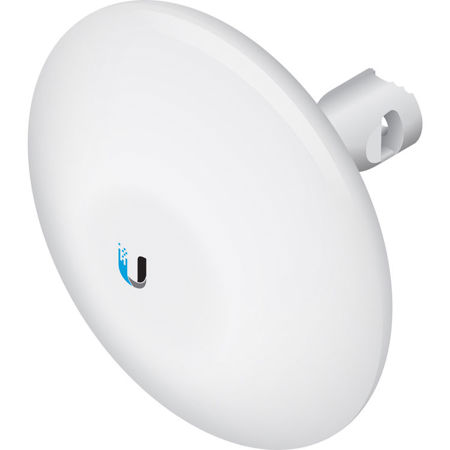
This item is no longer available.
Review Summary
2.4 GHz
150+ Mbps
15+ km
13 dBi
1x 10/100 Ethernet Port
Atheros MIPS 74Kc, 560 MHz
64MB DDR2, 8MB Flash
1x Power, 1x LAN, 4x WLAN
LEDs Software-Adjustable to Correspond to Custom RSSI Levels
5/8/10/20/30/40 MHz
Dual Linear
Outdoor UV Stabilized Plastic
Pole-Mount (Kit Included), Wall-Mount
45.4 N at 200 km/h (10.2 lbf at 125 mph)
200 km/h (125 mph)
Air: +/- 24 kV, Contact: +/- 24 kV
-40 to 80 deg. C / -40 to 176 deg. F
5 to 95% Noncondensing
FCC, IC, CE
Yes
IEC 68-2-11 (ASTM B117), Equivalent: MIL-STD-810 G Method 509.5
IEC 68-2-6
IEC 68-2-14
IEC 68-2-5 at 40 deg. C (104 deg. F), Equivalent: ETS 300 019-1-4
ETS 300 019-1-4, Equivalent: MIL-STD-810 G Method 506.5
24V, 0.5A PoE
6W
28 dBm
Modulation: 802.11g
Data Rate / Avg. TX / Tolerance
6 - 24 Mbps 26 dBm +/- 2 dB
36 Mbps 25 dBm +/- 2 dB
48 Mbps 24 dBm +/- 2 dB
54 Mbps 23 dBm +/- 2 dB
Modulation: 802.11n/airMAX
Data Rate / Avg. TX / Tolerance
MCS0 26 dBm +/- 2 dB
MCS1 25 dBm +/- 2 dB
MCS2 25 dBm +/- 2 dB
MCS3 25 dBm +/- 2 dB
MCS4 24 dBm +/- 2 dB
MCS5 23 dBm +/- 2 dB
MCS6 23 dBm +/- 2 dB
MCS7 23 dBm +/- 2 dB
MCS8 26 dBm +/- 2 dB
MCS9 25 dBm +/- 2 dB
MCS10 25 dBm +/- 2 dB
MCS11 25 dBm +/- 2 dB
MCS12 24 dBm +/- 2 dB
MCS13 23 dBm +/- 2 dB
MCS14 23 dBm +/- 2 dB
MCS15 23 dBm +/- 2 dB
Modulation: 802.11g
Data Rate / Avg. TX / Tolerance
6 - 24 Mbps -94 dBm Min. +/- 2 dB
36 Mbps -80 dBm +/- 2 dB
48 Mbps -77 dBm +/- 2 dB
54 Mbps -75 dBm +/- 2 dB
Modulation: 802.11n/airMAX
Data Rate / Avg. TX / Tolerance
MCS0 -96 dBm +/- 2 dB
MCS1 -95 dBm +/- 2 dB
MCS2 -92 dBm +/- 2 dB
MCS3 -90 dBm +/- 2 dB
MCS4 -86 dBm +/- 2 dB
MCS5 -83 dBm +/- 2 dB
MCS6 -77 dBm +/- 2 dB
MCS7 -74 dBm +/- 2 dB
MCS8 -95 dBm +/- 2 dB
MCS9 -93 dBm +/- 2 dB
MCS10 -90 dBm +/- 2 dB
MCS11 -87 dBm +/- 2 dB
MCS12 -84 dBm +/- 2 dB
MCS13 -79 dBm +/- 2 dB
MCS14 -78 dBm +/- 2 dB
MCS15 -75 dBm +/- 2 dB
189 x 189 x 125mm / 7.44 x 7.44 x 4.92"
0.53kg / 1.17lbs
Starting with the first-generation NanoBridge, Ubiquiti Networks pioneered the all-in-one design for an airMAX product functioning as a CPE (Customer Premises Equipment). Now Ubiquiti Networks launches the latest generation of CPE, the NanoBeam.
Improved Noise Immunity
Available for the 2.4 and 5 GHz frequency bands, the NanoBeam directs RF energy in a tighter beam width. With the focus in one direction, the NanoBeam blocks or spatially filters out noise, so noise immunity is improved. This feature is especially important in an area crowded with other RF signals of the same or similar frequency.
Integrated Design
The Ubiquiti Research and Development team combined the radio and antenna to create a more efficient and compact CPE. The NanoBeam gets maximum gain out of the smallest footprint. Providing increased performance from its faster processor and innovative mechanical design at a low cost, the NanoBeam is extremely versatile and cost-effective to deploy.
airMAX Technology Included
Unlike standard Wi-Fi protocol, Ubiquiti's Time Division Multiple Access (TDMA) airMAX protocol allows each client to send and receive data using pre-designated time slots scheduled by an intelligent AP controller. This time slot method eliminates hidden node collisions and maximizes airtime efficiency. It provides significant performance improvements in latency, throughput and scalability compared to all other outdoor systems in its class.
Intelligent QoS
Priority is given to voice/video for seamless streaming.
Scalability
High capacity and scalability.
Long Distance
Capable of high-speed, carrier-class links.
Plug and Play Installation
The NanoBeam mounts to a variety of surfaces including poles or walls and offers the freedom of three-axis alignment. No screws are required for pole-mounting and only a single wall screw (not included) is required for wall-mounting.
Incredible Antenna "Beam" Performance
The form factor of the NanoBeam features the highest gain for its size. The Nano Beam's excellent beam directivity provides the best performance in high-noise environments.
Advanced Software Technology
Ubiquiti's airMAX technology is proven in millions of deployments worldwide, exhibiting outstanding performance in outdoor environments. The TDMA airMAX protocol enables unprecedented scalability, high throughput and low latency in unlicensed, multipoint networks.